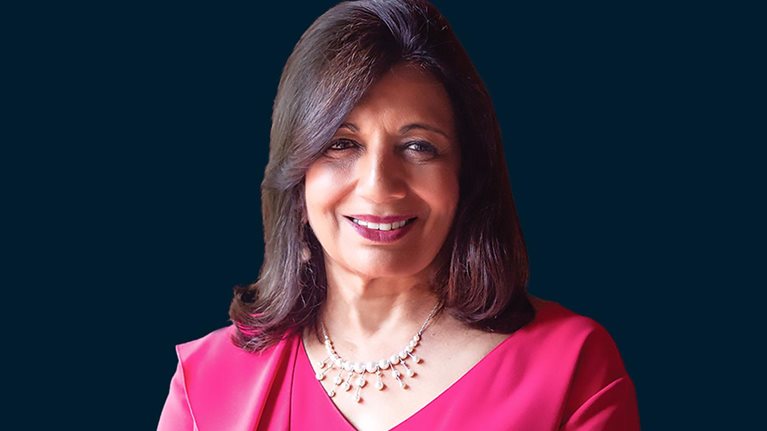This interview is part of the Leading Asia series, which features in-depth conversations with some of the region’s most value-creating leaders on what it takes to realize bold ambitions and take them further.
Tan Su Shan, the first woman to lead DBS Bank, is ramping up its AI transformation as the technology rapidly evolves. “AI is eating the world,” Tan said, adding that staying ahead of AI trends requires nimbleness, agility, and open-mindedness. DBS, Southeast Asia’s largest bank by assets, is known for its leading approach to technology and expertise in AI, and Tan, its first CEO to be appointed from within, has been steeped in the bank’s transformation-focused culture. Since assuming the top job in March, Tan has taken this digital-first approach forward, viewing AI as a game changer in banking.
Her time at DBS has given her a good overview of the bank’s sprawling empire. During the 15 years she spent at DBS before becoming CEO, she managed the consumer banking, wealth management, and institutional banking businesses. Her previous experience includes tenures at Morgan Stanley and Citigroup, and she has worked in financial centers including Hong Kong, London, and Tokyo.
In this Leading Asia interview, McKinsey Senior Partner Vinayak HV spoke with Tan at DBS’s headquarters to discuss her views on AI; leadership; the bank’s environmental, social, and governance (ESG) commitments; and McKinsey’s role in the bank’s transformation. (See impact summary, “The DBS-McKinsey partnership”). The following is an edited transcript of the conversation.
Vinayak HV: Su Shan, which leadership experiences have prepared you most to become the CEO of DBS?
Tan Su Shan: There are so many. I think one big philosophy I’ve always ascribed to is, when things are really good, don’t lose your head; when things are really bad, don’t lose your heart. That’s helped us through the ups and downs of global crises and market volatility.
Another crucial thing is to pick the best team. If you’re good at strategy or you’re good at execution or you’re good at marketing, find people who complement your skills, people who are effective in the nitty-gritty—in technology and operations, control, governance, compliance, whatever it is. Create a diverse team, create trust within the team, and then go forth and conquer as a team.
When things are really good, don’t lose your head; when things are really bad, don’t lose your heart.
Leadership in volatile times
Vinayak HV: As you look ahead, what do you think is going to be most important, in terms of leadership, to make DBS successful and achieve the bold vision that you have for it?
Tan Su Shan: Great volatility requires leaders who are agile. That means you’re able to pivot when you have to pivot. You’re able to change when you have to. And you’re able to meet whatever crisis or whatever sudden changes come your way.
That means creating teams that are agile, and planning for almost every possible scenario—no matter how bad or how good. And it means working horizontally, which is something that Piyush Gupta, our previous CEO, created. In praise of his legacy, I think the way we have organized ourselves—in terms of teamwork, data, and being digitally able—these are the edges or the “moats” we have created to face whatever volatility the market throws at us, whatever geopolitical changes there are, whatever technological disruptions there might be.
AI is eating the world. You’ve got the birth of data centers and the demise of other industries, for example. Just being ahead of these trends requires a fair amount of open-mindedness, agility, and nimbleness. Having that sort of constant eye on the future—“What’s cooking now?”—requires that ambidextrous leadership.
Vinayak HV: You’re present in the big financial centers—Singapore, Hong Kong. You also present a very interesting portfolio of markets—India, China, Indonesia. But the world is getting more complicated. There is macrovolatility. How do you think about navigating these uncertain times?
Tan Su Shan: We have been very clear what we want to be: We want to be an Asian bank. We want to stay focused on our backyard because Asia is a big market. China, India, and Indonesia are the three biggest markets we have. All have different growth paths, and they don’t necessarily move up and down together. But they all have structural growth, and they’re all exciting in terms of technological adoption, being future ready, the tech stack, et cetera.
And then, Singapore and Hong Kong are our two main financial hubs servicing different parts of Asia, so they’re pretty complementary. Both are mature financial markets. Singapore services Southeast Asia and is big on FICC [fixed income, currencies, and commodities] as well as wealth management. Hong Kong is strong in equity capital markets and financial wealth management, and services more of the North Asia flows.
How do you navigate geopolitics? Well, you ringfence North Asia, so Hong Kong remains the financial hub for the north. You ringfence your capital, you ringfence your risks, your technology, your tech stack. You try to have interoperability when you need to, but you are also able to be quite nimbly independent and self-funded when you need to be.
A purpose-driven bank
Vinayak HV: DBS is a purpose-driven institution—you play a strong role in society, and you also stick with some difficult things, such as your commitment to sustainability. How do you think about the role of purpose, as well as sticking with your commitments during changing times?
Tan Su Shan: Our purpose is what defines us. DBS stands for the Development Bank of Singapore. We were founded in 1968, shortly after Singapore gained independence in 1965. We needed to develop Singapore—to help with the fledgling businesses, the ports, the real estate industry, and so on. We were born out of the Singapore Economic Development Board to finance the country’s development. We have since morphed into a commercial bank, but we kept those developmental roots because they make up the very purpose that binds us as an organization.
And that’s not just in Singapore; it’s in all the core markets we work in. For example, in 2023, we made a commitment to spend up to 1 billion Singapore dollars [$782 million] over ten years to improve the lives of low-income people in our key markets. It’s part of who we are and what we represent: to put energy, capital, and effort behind helping to address issues, including aging and climate change.
We cannot do this alone. We’ve got to do it with the communities we work in, with the government, with partners. But we’ve certainly put a lot into making this work in the countries that we are present in.
Impact summary: The DBS-McKinsey partnership
DBS transformed into a technology-powered organization by setting up cross-functional teams of data scientists, AI experts, technologists, and business leads—all working together to harness AI and data to better serve tech-savvy customers. The goal was to make banking seamless for this new generation of customers, a major undertaking that required buy-in from employees across the bank. McKinsey worked closely with DBS on the transformation. The impact? A year saved in end-to-end AI deployment time, additional economic value of 750 million Singapore dollars ($585 million) in 2024 thanks to AI and data initiatives, and a 50 percent reduction in the cost-to-income ratio of serving digital customers compared with traditional customers.
In this excerpt from the interview, the CEO reflects on DBS’s, and her own, experiences with McKinsey.
Vinayak HV: Can you tell us about the impact our firm had on DBS’s transformation?
Tan Su Shan: McKinsey has been good at macro themes and framing. You helped us with the data lake, how we’ve looked at industrializing, the use of AI, creating feedback loops, working with QuantumBlack—your AI consulting arm—to ensure that our models improve with the constant feedback loop.
That was a useful kickstart for us to embrace AI. I still remember when we did a kick start QuantumBlack town hall together with my team, making sure that everyone embraces this as part of their everyday lives. It’s a cultural mindset shift, and it takes time.
But once they do it, they embrace it. It becomes part and parcel of our business as usual. You’ve got to make it fun so everyone uses it. That was part of our joint journey, and I think it will continue to evolve.
Vinayak HV: Could you tell us about your own personal experience working with our firm?
Tan Su Shan: On a personal level, I found your mentorship for new CEOs very useful—meeting my peers who are new CEOs, getting to know their challenges, and creating a network to discuss sometimes tricky situations: “How are you managing new technology or navigating change?” Having an independent third party that knows you well and can help you with that transition was very useful. Being able to talk to my peers (in the McKinsey Center for CEO Excellence program) and find out what could go wrong that we’re not thinking about was also very useful.
For more on the history and impact of DBS’s transformation, see:
DBS: Transforming a banking leader into a technology leader
An inside look at how McKinsey helped DBS become an AI-powered bank
Digital bank with a heart
Vinayak HV: Over the last decade, you’ve transformed from being the Development Bank of Singapore to increasingly being known as the “Digital Bank of Singapore.” Now we are in the age of AI, and you’ve been leading a number of AI initiatives. Could you give us some examples of where you’re seeing the value from AI?
Tan Su Shan: We started our AI journey a long time ago—probably over ten years ago, when we realized that we needed to get our data sorted out. We created a data lake. And then we worked to industrialize the use of data so that we could create models that could come up with contextual offers or recommendations for our consumer bank, for our SME [small and medium-size enterprise] customers, et cetera. And then we did A/B testing.
That helped us to create 1,300 to 1,600 models. When we tracked the outcomes from the A/B tests, we realized that in 2024, AI and data analytics delivered about 750 million Singapore dollars in economic value for DBS. This year we’re on track, hopefully, to reach 1.1 billion to 1.2 billion Singapore dollars in economic value. It’s a result of everything we’ve done: being a data-driven organization, being a digital organization, and increasingly being a gen AI–enabled organization as well.
But it’s not just about the tech; it’s also about the people. We want to be gen AI enabled, but we also want to be an empathetic organization: a gen AI–enabled bank with a heart. That’s our internal motto; that’s what we want to be.
We want to be gen AI enabled, but we also want to be an empathetic organization: a gen AI–enabled bank with a heart.
McKinsey: I love it. You spoke about the value of AI. One of the challenges many CEOs are grappling with is the risks. How do you think about managing the risks associated with AI, particularly gen AI?
Tan Su Shan: Our philosophy concerning the use of data is very clear. We have the PURE framework. P stands for purposeful use of data. U stands for unsurprising, meaning that you cannot use data that would surprise or embarrass your customer. R is for being respectful in how the data is collected and communicated. And E stands for explainable, meaning that the logic behind how AI models generate outcomes should be understandable.
That’s the principle. Then we have guardrails and protocols. Where does the data come from? Who has access to that data? Are your models working? Are they fair? And when you are using gen AI, for example, is it hallucinating? Putting a human in the loop ensures it doesn’t hallucinate. Making sure the data is secure is also important. Being clear about who is responsible for what is also important.
Our philosophy concerning the use of data is very clear. We have the PURE framework—P stands for purposeful. . . . U stands for unsurprising. . . . R is for being respectful. . . . and E stands for explainable.
McKinsey: What do you think lies ahead on DBS’s AI journey? And what’s your vision for the bank?
Tan Su Shan: We’re all in on AI, and our job is to make sure our technology is resilient. We need to get the basics right: the right guardrails and clean data. We have a culture focused on transformation, innovation, and learning. We’re all learning together. When we worked with McKinsey on gen AI, we said, “OK, there will be horizontal gen AI journeys that everyone can use, and there will be vertical journeys that specify use cases that we want to try it out on. There will be successes; there will be failures; and we are going to have to share quite openly about both.”
For example, we have DBS GPT—a gen AI model similar to ChatGPT—that’s available to our employees. We have a very active user rate. A lot of people are using it for translations because there are many different languages in our markets. They are using it to write better letters to customers. People in call centers are using it to answer customer queries. People in branches who might come from a retail background are using DBS GPT to help them answer questions on SME banking, for example. It enables a lot more democratization of DBS knowledge for all our staff, and that’s been very helpful.

Leading Asia
The vertical use cases have led to quite a lot of productivity gains. One example is the ESG questionnaire, which is a requirement for many of our corporate clients; a lot of our corporate bankers were spending a lot of time answering it. Today, gen AI really helps. Another example is documentary trade, where a seller’s bank collects payment from a buyer through the exchange of trade documents. These documents are filled with legal jargon. In the past, we had humans looking at them. Today, AI does a far better, faster job to make sure the legal documents are clean. We also use AI for adverse media screening to identify potential risks associated with people or entities for the purposes of anti–money laundering and know your customer compliance.
Last year, we launched a gen AI–enabled bot for our SME clients that can help them with things like account balances, transaction history, and locating ATMs.
ESG commitments: Responsibility and pragmatism
Vinayak HV: One of the big commitments you and other banks have made is to ESG. But there’ve also been a lot of changes in posture across financial institutions. You’ve stayed committed. Can you talk to me a little bit about your ESG commitment and why it is important?
Tan Su Shan: Climate is one of these societal problems that we have to deal with, and as a purpose-driven bank, we have to be responsible. To your ESG question, we’ve always taken the view that we want to be pragmatic, so you can’t “boil the ocean.” Living in Asia, we’re in different economic cycles versus the West. We have to recognize what else societies in Asia need. They need affordable, reliable energy. They need energy security.
How do you play a part in that and help them to transition? We want to be pragmatic. We want to be impactful. We want to do stuff that has impact on bringing down CO2, and we want to be that trusted partner to help our customers transition.
We were the first bank that came up with our own transition taxonomy before countries and governments came up with theirs. We understand that Asia is on a different growth path. Asian societies may have different affordability curves; we can’t go from brown to green immediately. We might have to go into gas as a transition fuel, for example.
And if you want to be impactful, you might have to shut down coal-fired power plants early. And so we do energy-transition-mechanism deals, which essentially means you have to bank more coal deals to help the industry shut down early. You have to bring in blended finance partners. You have to pay for it. Someone’s got to fund it in order to shut it down early. How do you make it economically viable? You sell carbon credits. You have to find ways to make this work.
That’s what I mean by being impactful but pragmatic—that’s what we do. And we believe that, in the long term, it’s the right thing to do. I looked at our portfolio, and we said, “Here are seven to nine industries that we think have the most CO2 emissions. How do we help them to measure?” Then we come in with solutions—and finance those solutions—that will help them to start their glide path down.
We were the first bank that came up with our own transition taxonomy before countries and governments came up with theirs.
Vinayak HV: DBS’s transformation has received a number of recognitions. What are you most proud of?
Tan Su Shan: I am really proud of the way the new leadership team has galvanized into building trust and being recognized for it. We won three Euromoney Awards for Excellence this year: the World’s Best Bank Award, the World’s Best Bank for Corporate Responsibility Award, and the World’s Best Bank for Customer Experience Award. I am so proud of the team. I feel validated because of all the hard work we put into making customers’ journeys joyful and being laser focused on customer outcomes and customer experiences.

